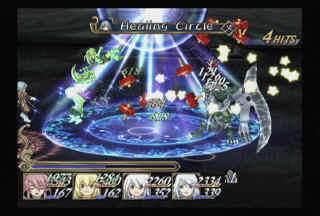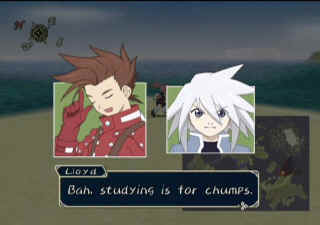Tales of Symphonia is a breath of fresh air
for RPG-starved Gamecube owners. Not fresh in the sense of being a completely original
game, indeed it unashamedly borrows from other RPGs, but fresh in that it is an epic
adventure of grand proportions in a well executed and lovingly detailed environment.
 The Tales series is rather long running in Japan, but
American releases have been somewhat sparse. Symphonia follows in the series'
tradition with a tweaked battle system of real-time frantic play.
The Tales series is rather long running in Japan, but
American releases have been somewhat sparse. Symphonia follows in the series'
tradition with a tweaked battle system of real-time frantic play.
The story follows the exploits of young Llyod Irving and his cohorts, notably Colette
Brunel. Colette is the Chosen One (one to every generation - just like Buffy) of
Sylvarant, destined to save the dying world from mana depletion. Unbeknownst to their
party, Sylvarant is a world connected in a symbiotic relationship to another world. While
one flourishes, the other perishes. Llyod vows to save both worlds and must face dangers
on an epic scale in order to fulfill his dream.
While the story is somewhat unoriginal and bears a superficial resemblance to Final
Fantasy X, it is very well executed. It certainly could have been deeper; more
attention is paid to character development than plot development, but enough twists and
turns abound to keep even hardened cynics entertained. Some few FMV cut scenes are
sprinkled throughout the gameplay.
Characterization is deep and thoughtful; the characters grow and change throughout the
story. Interactive skit elements, in addition to the main storyline, add to the story
depth. Numerous sidequests will allow the player to further the discovery of the two Symphonia
worlds.
Perhaps the best feature of Symphonia is its easy to pick-up, but hard to master
battle system. Players will actively control one character out of the group of four, and
assign a general strategy for everyone else. Of course, it is very possible (and sometimes
needful) to assign specific commands to specific characters during the course of battle.
 Battle is real-time in a multi-planar environment. Characters
will orient on a specific enemy and attack on its plane - sometimes hitting just that
enemy, sometimes striking a group. Noticing the distance relationship between enemies (and
friends) plays a large role in the strategy, especially when it comes to the casting of
multi-target spells.
Battle is real-time in a multi-planar environment. Characters
will orient on a specific enemy and attack on its plane - sometimes hitting just that
enemy, sometimes striking a group. Noticing the distance relationship between enemies (and
friends) plays a large role in the strategy, especially when it comes to the casting of
multi-target spells.
Apart from basic attacking, characters learn a wide variety of skills and magics, mostly
unique to each character. Further, the type of skills learned by each character can be
customized by choosing EX skills, provided one has the appropriate EX gem; these skills in
turn can be combined to form new skills. The combination possibilities for a single
character in terms of skill/magics are quite numerous.
Strategy can be set for each individual team member, ranging from "do nothing"
to "attack with everything." Positions can also be assigned, and the AI is
relatively good at following orders. The party can also perform unison attacks after
filling the unison gauge; this attack allows a free assigned hit from each character and
can combo to form special attacks that do massive damage.
After battle, one character can be chosen to cook for the party. These meals will have a
variety of effects, from general healing to curing ailments. New recipes are discovered
throughout the adventure, and each character has their own skill level; some characters
are great chefs while others will barely avoid poisoning the party. Ingredients are also
scattered throughout the world.
Another important aspect of Symphonia is its usage of titles. Titles are gained
either through the storyline or by completing certain requirements or a mini-game, etc.
Unlike most RPGs, these titles have a direct impact on the characters by influencing which
characteristics are upgraded at a level up. Some titles even change the outfits of
characters.
 Some of these titles can be quite frustrating to obtain, requiring
an absurd amount of time in mini-game play. Completion freaks should take note: it is
impossible to complete and see everything in anything less than three full playthroughs.
While there is significant replay value, Symphonia is not a short game by any
standard; not being able to achieve every title on the first (or second) run may leave
some frustrated. Fortunately, the game does offer a break for those going through multiple
times: GRADE is earned in every battle and can be used to purchase bonuses (keeping
titles/skills/money) for the next game. Masochists should also note that GRADE could be
used to make the next game even harder.
Some of these titles can be quite frustrating to obtain, requiring
an absurd amount of time in mini-game play. Completion freaks should take note: it is
impossible to complete and see everything in anything less than three full playthroughs.
While there is significant replay value, Symphonia is not a short game by any
standard; not being able to achieve every title on the first (or second) run may leave
some frustrated. Fortunately, the game does offer a break for those going through multiple
times: GRADE is earned in every battle and can be used to purchase bonuses (keeping
titles/skills/money) for the next game. Masochists should also note that GRADE could be
used to make the next game even harder.
Visually, the game features a cel-shading on 3D backgrounds. Cel-shading is something
either hated or loved, but Symphonia utilizes the art to render a gorgeous and
breath-taking vista. Aurally, the soundtrack is an excellent effort and provides perfect
ambiance for most sections of the game. Voice acting is definitely a cut above average
with numerous veteran actors lending their considerable talents.
Tales comes highly recommended to all Gamecube owners. Indeed, it might be enough
reason to purchase a Gamecube.